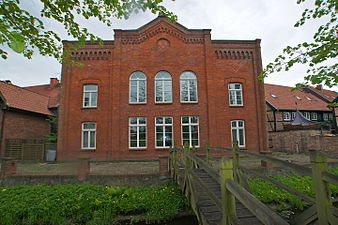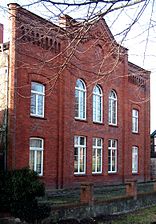Synagogue (Boizenburg)
The synagogue in Boizenburg was the religious meeting place of the local Jewish community until 1892. The secular synagogue has been a protected monument since 1984 .
history
As early as the 13th century, Jewish residents of the town of Boizenburg were mentioned, who were liable to pay taxes to the sovereign. In return, the sovereign allowed resident Jews to trade.
As a result of the Sternberg host-molester trial of 1492, there was also the forced expulsion of the local Jews in Boizenburg. It was not until the middle of the 18th century that Jews were able to participate in the flourishing trade in the city again. However, you need a so-called letter of protection , which was issued by the ruling Mecklenburg duke against payment of 5 to 15 thalers .
In 1799, the Boizenburg Jewish community decided to build a synagogue. From 1799 to 1801 a representative half-timbered building was built in Wallstraße 48, today's Kleine Wallstraße 7. In 1846, however, the poor structural condition was noted, so that no more church services could be held in the foreseeable future.
In 1864 the synagogue was finally repaired and modernized. For this purpose, a total of 250 thalers were donated from the house of the Mecklenburg Grand Duke Friedrich Franz II . During this time the building received the imposing red brick façade that is still visible today. The ceremonial reopening of the synagogue on September 27, 1864, in the presence of the regional rabbi Salomon Cohn , marked the end of the repair work. Numerous residents of the city and guests of honor attended the celebrations. The pageant began its way to the new synagogue in front of the house of the Jewish merchant Lazaurus, who lived on Baustraße. The festive procession was led by children of the community, one of whom carried the key to the new synagogue on a blue velvet cushion. The three building masters, representatives of the city and offices, regional rabbi Cohn with the two bearers of the valuable Torah scrolls and finally the community members of the Boizenburg Jewish community joined the pageant .
In the following decades the number of parishioners steadily decreased, so in 1892 there were only 19 parishioners. The decrease in the number of parishioners was also related to the lifting of residence restrictions for Jews. As the maintenance of the synagogue could no longer be guaranteed, the community finally had to sell the building in 1892. A buyer was soon found for the representative building, the Masonic Lodge Vesta , founded on November 5, 1822, to the three towers .
From then on, the remaining Jewish community members held their services in the house of the merchant David Lazarus at Baustraße 25 until he too sold his house.
In 1922, the 62-member Johannisloge Vesta celebrated its centenary festival at the three towers . Numerous lodge brothers of the country took part in the celebrations, the climax of which was the temple celebration led by lodge master Conrad Beckhaus.
The takeover of power by the National Socialists not only threatened Jewish life in Germany, the members of the Masonic lodges were also targeted by the Nazi regime . After all Masonic lodges were banned , the Boizenburg Masonic lodge was also expropriated. For this reason, the former synagogue building was taken over by the city of Boizenburg in March 1934 and used as a local museum from September 29, 1935 . In the course of the new use, extensive changes were made to the external appearance. At the end of the Second World War , the museum stock was relocated due to the war. The museum of local history could only be reopened in 1958. The museum stayed in the former synagogue until 1980. Subsequently, a music cabinet was set up in the premises , which was used until 1991. In 1993 the city of Boizenburg returned the former synagogue to the Masonic Lodge Vesta at the three towers . The building remained in their possession until October 2015. In the same month, the Guru Ram Das Aquarian Academy took over the historic building.
synagogue
Building description
The synagogue was originally a simple multi-storey half-timbered building, with a gable roof at the top . The renovation work of 1864 resulted in fundamental changes in appearance. So the high gables were made of red brick. The gables are bordered by bricked octagonal pillars, which are crowned with octagonal flattened pyramids. On the gables there are cornices , toothed friezes and round arch friezes as decorative elements. The triangular gable on the east side is in turn crowned by a sandstone decorated with volutes. There are also numerous high, round-arched and rectangular windows on the building, some of which were only added during the renovation work in 1934. As part of the renovation work, the Misrach window , the Aron Hakodesch bay below, in which the niche of the Torah shrine was located until 1892 , and the flanking windows of the east gable were removed. The three-part round arched niche above the Misrach window also disappeared. The raised ends of the triangular gables were also completely removed. During this renovation, which the city of Boizenburg approved in September 1934, almost all visible structural features of a synagogue were ultimately removed. Only the west gable still shows characteristics from the time of origin.
The current appearance of the former synagogue is the result of extensive renovation work in 1934. Inside the house, a memorial plaque reminds of the decades of use by the Israelite religious community.
Torah Shrine and Torah Scrolls
Torah shrine
After the synagogue was built in 1801, the Jewish community commissioned the manufacture of a Torah shrine . The exterior of the shrine was pearly white, while the interior was gray. The pillars flanking the shrine were marbled in red . The shrine was also adorned with decorative elements, which were presented as a gilded crown over the tablets of the law and paintings.
Nothing is known about the whereabouts of the Boizenburg Torah Shrine.
Torah scrolls
The Boizenburg community owned five Torah scrolls. After the synagogue was sold, they were taken into custody by the local council. The Boizenburg merchant and parishioner Franz Wolff took the Torah scrolls with him to Hamburg in the 1930s. There they were burned for “being bad”.
Municipal statistics 1768–1938
In the 1930s, the few remaining Jewish residents left the city. Merchant Franz Wolff gave up his clothing store, which was located in today's town hall, in 1931. He later moved to Hamburg. The last Jewish citizens to leave the city in 1938 were Bernhard Cohn, who until then had kept the community's birth records, and his daughter Berta.
| year | Jews | Familys |
|---|---|---|
| 1768 | - | 4th |
| 1805 | - | 5 |
| 1810 | 36 | - |
| 1819 | 51 | - |
| 1828 | 63 | - |
| 1846 | 38 | - |
| 1892 | 19th | - |
| 1910 | 10 | - |
| 1924 | - | 3 |
| 1933 | - | 2 |
| 1937 | 2 | - |
| 1938 | - | - |
gallery
See also
Literature and Sources
literature
- Klaus-Dieter Alicke: Lexicon of the Jewish communities in the German-speaking area. 3 volumes. Gütersloher Verlagshaus , Gütersloh 2008, ISBN 978-3-579-08035-2 . ( Digitized version )
- Klaus Arlt: Evidence of Jewish Culture: Memorials in Mecklenburg-Western Pomerania, Brandenburg, Berlin, Saxony-Anhalt, Saxony and Thuringia. Tourist Verlag, Berlin 1992, ISBN 978-3-350-00780-6 , p. 23 f.
- Jürgen Borchert , Detlef Klose: What remained ...: Jewish traces in Mecklenburg. Haude & Spener publishing house, Berlin 1994, ISBN 978-3-775-90391-2 , p. 101 f.
- Leopold Donath : History of the Jews in Mecklenburg: from the oldest times (1266) to the most recent times (1874). Publishing house Oskar Leiner, Leipzig 1874.
- Karl-Heinz Lock: Between angles and compasses. Contributions to the history of Freemasonry in Mecklenburg-Western Pomerania. Verlag Stock und Stein, Schwerin 1995, ISBN 978-3-910-17949-3 .
Printed sources
- Heidemarie Gertrud Vormann: Architectural history studies on the synagogues in Mecklenburg. Inaugural dissertation TU Braunschweig , Braunschweig 2012.
- Erika Will: Jewish past in Boizenburg. In: Heimatmuseum Boizenburg (ed.): Boizenburg: Contributions to the history of the city. No. III. Boizenburg 1985, p. 9 f, p. 23 f.
- Werner Schinko: The synagogue in Boizenburg. In: Mecklenburg-Magazin. No. 19 (1996). Landesverlags- und Druckgesellschaft, Schwerin, p. 2.
Unprinted sources
-
State Main Archive Schwerin
- Holdings: (10.72-3 / 3), church books (soul books) and church book copies of the Jewish communities: u. a. Jewish community of Boizenburg 1813–1925, duration : n.a.
Web links
- Boizenburg Synagogue at juden-in-mecklenburg.de
- Archive Centrum Judaicum
Individual evidence
- ^ Leopold Donath: History of the Jews in Mecklenburg: from the oldest times (1266) to the most recent times (1874). Verlag Oskar Leiner, Leipzig 1874, p. 327 ff.
- ↑ a b In: Wochenblatt für Boizenburg, Hagenow, Wittenburg und Umgebung No. 79, from October 1, 1864.
- ^ Calendar for the Provincial Lodge of Mecklenburg and the lodges belonging to their district. Hinstorffsche Hofbuchhandlung, Ludwigslust / Parchim 1841, p. 136 ff.
- ^ Klaus Arlt: Evidence of Jewish culture: memorial sites in Mecklenburg-Western Pomerania, Brandenburg, Berlin, Saxony-Anhalt, Saxony and Thuringia. Tourist Verlag, Berlin 1992, p. 23.
- ↑ Uwe Wieben: People in Boizenburg: Their work in politics and culture, in handicrafts, in the shipyard and in the record factory in the late 19th and early 20th centuries. Akademische Verlagsanstalt, Leipzig 2013, ISBN 978-3-931982-80-5 , p. 54.
- ↑ Centrum Judaicum inventory: 1.75 A, Bo4, No. 5 (Ident. No. 872), Bl. 2a – 3 and 4.
- ↑ LHAS inventory: (10.72-1), Israelitischer Oberrat: No. 144, letter Berta Cohn to lawyer Richard Josephy (1890–1944) dated February 16, 1937 (page 2).
- ↑ Helmut Eschwege : History of the Jews in the territory of the former GDR. III. Tape. Self-published, Dresden 1990, p. 1024 f.
Coordinates: 53 ° 22 ′ 30.6 " N , 10 ° 43 ′ 29.9" E







